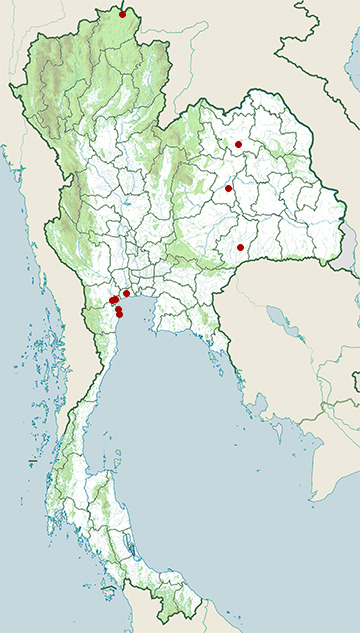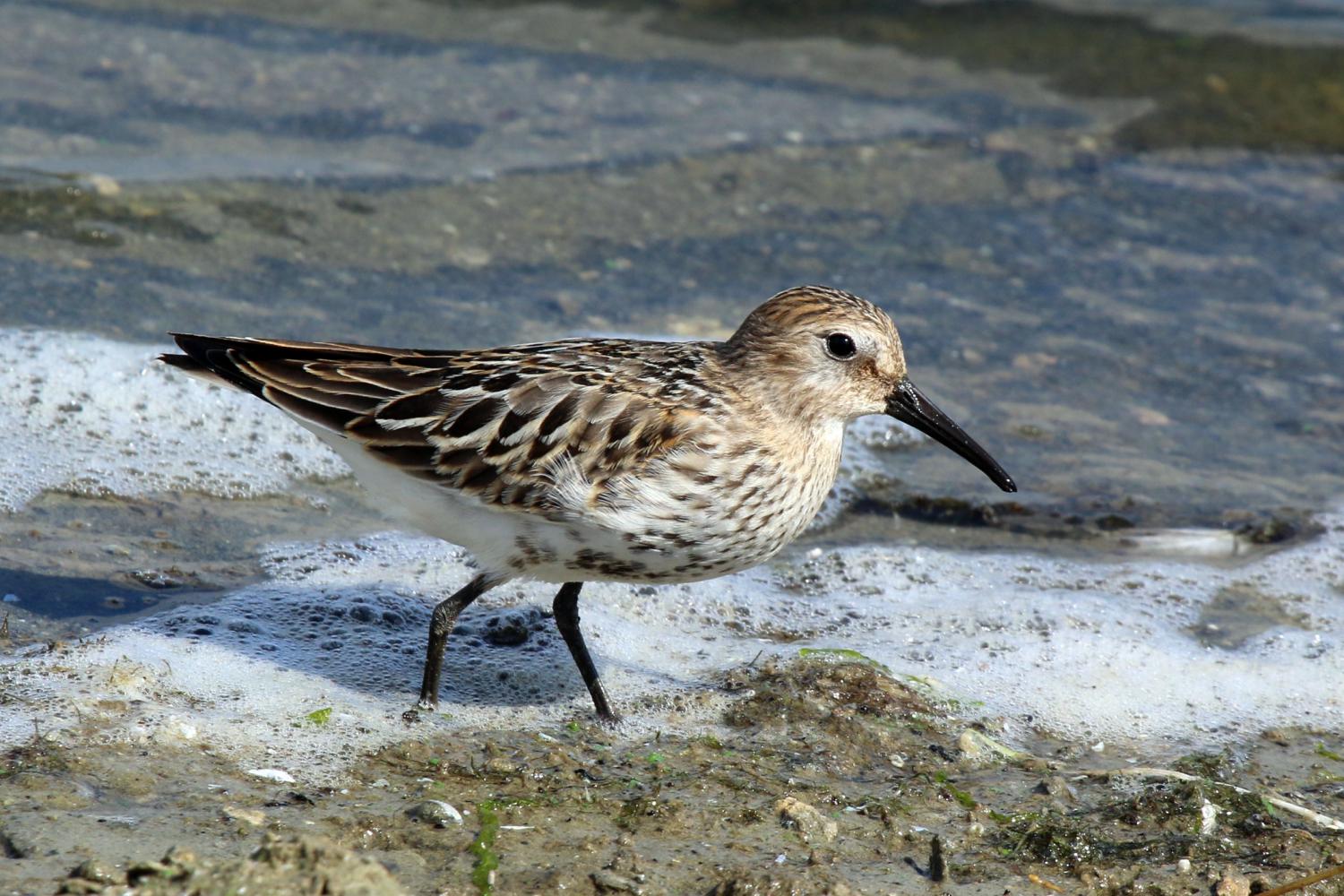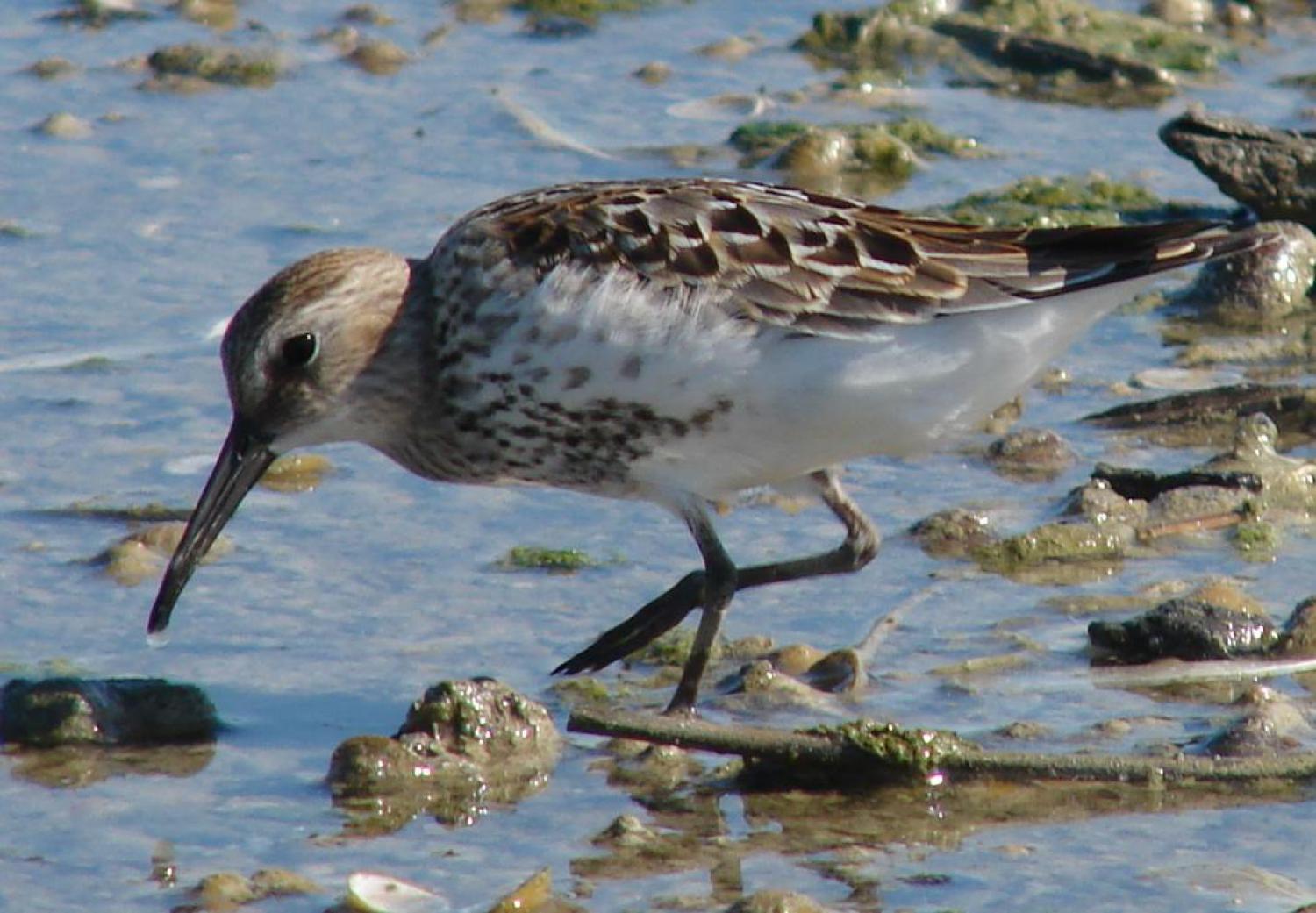Species of Thailand
Dunlin
Calidris alpina
Carolus Linnaeus, 1758
In Thai: นกชายเลนท้องดำ
The dunlin (Calidris alpina) is a small wader, sometimes separated with the other "stints" in Erolia. The English name is a dialect form of "dunling", first recorded in 1531–2. It derives from dun, "dull brown", with the suffix -ling, meaning a person or thing with the given quality. The genus name is from Ancient Greek kalidris or skalidris, a term used by Aristotle for some grey-coloured waterside birds. The specific alpina is from Latin and means "of high mountains", in this case referring to the Alps.
It is a circumpolar breeder in Arctic or subarctic regions. Birds that breed in northern Europe and Asia are long-distance migrants, wintering south to Africa, southeast Asia and the Middle East. Birds that breed in Alaska and the Canadian Arctic migrate short distances to the Pacific and Atlantic coasts of North America, although those nesting in northern Alaska overwinter in Asia. Many dunlins winter along the Iberian south coast.
Description
An adult dunlin in breeding plumage shows the distinctive black belly which no other similar-sized wader possesses. The winter dunlin is basically grey above and white below. Juveniles are brown above with two whitish "V" shapes on the back. They usually have black marks on the flanks or belly and show a strong white wingbar in flight.
The legs and slightly decurved bill are black. There are a number of subspecies differing mainly in the extent of rufous colouration in the breeding plumage and the bill length. Bill length varies between sexes, the females having longer bills than the males.
On the tip of the Dunlin's bill is a soft covering that fills with blood and with many nerve endings, forming a sensitive probe that is used to locate invertebrate prey in mud and sand. Although the bill can look sharp-pointed in dead specimens, in life it is blunt.
Subspecies
- C. a. arctica, (Schiøler, 1922), breeds in northeast Greenland.
- C. a. schinzii, (Brehm & Schilling, 1822), breeds in southeast Greenland, Iceland, the British Isles, Scandinavia & the Baltic.
- C. a. alpina, (Linnaeus, 1758), breeds in northern Europe and northwest Siberia.
- C. a. centralis, (Buturlin, 1932), breeds in north-central and northeast Siberia.
- C. a. sakhalina, (Vieillot, 1816), breeds in eastern Russia to the Chukchi Peninsula.
- C. a. kistchinski, Tomkovich, 1986, breeds around the Sea of Okhotsk to Kuril Islands and Kamchatka.
- C. a. actites, Nechaev & Tomkovich, 1988, breeds on Sakhalin.
- C. a. arcticola, (Todd, 1953), breeds from northwest Alaska to northwest Canada.
- C. a. pacifica, (Coues, 1861), breeds in western and southern Alaska.
- C. a. hudsonia, (Todd, 1953), breeds in central Canada.
Nesting
The nest is a shallow scrape on the ground lined with vegetation, into which typically four eggs are laid and incubated by the male and female parents. Chicks are precocial, however are brooded during early development. They start to fly at approximately three weeks of age. The majority of brood care is provided by the male, as the female deserts the brood and often leaves the breeding area.
The call is a typical sandpiper "peep", and the display song a harsh trill.
The dunlin is one of the species to which the Agreement on the Conservation of African-Eurasian Migratory Waterbirds (AEWA) applies.
Apparent hybrids between this species and the white-rumped sandpiper as well as with the purple sandpiper have been reported from the Atlantic coasts of North America and Europe, respectively.
Behaviour
The dunlin is highly gregarious in winter, sometimes forming large flocks on coastal mudflats or sandy beaches. Large numbers can often be seen swirling in synchronized flight on stop-overs during migration or on their winter habitat.
This bird is one of the most common waders throughout its breeding and wintering ranges, and it is the species with which other waders tend to be compared. At 17 – 21 cm length and with a 32 – 36 cm wingspan, it is similar in size to a common starling, but stouter, with a thicker bill.
The dunlin moves along the coastal mudflat beaches it prefers with a characteristic "sewing machine" feeding action, methodically picking small food items. Insects form the main part of the dunlin's diet on the nesting grounds; it eats molluscs, worms and crustaceans in coastal areas.
Dunlin are small migratory waders, however they show strong philopatry with individuals of the Southern Dunlin (Calidris alpina schinzii) in Sweden and Finland returning to, or very close to, their natal patches. Habitat fragmentation has reduced the availability of habitat patches to these birds through reducing patch size and increasing patch isolation. This reduced connectivity between patches has reduced the movements of Dunlin leaving them more susceptible to inbreeding in these locations. Future management for the conservation of Southern Dunlin should include increasing the connectivity between habitat patches.
This article uses material from Wikipedia released under the Creative Commons Attribution-Share-Alike Licence 3.0. Eventual photos shown in this page may or may not be from Wikipedia, please see the license details for photos in photo by-lines.
Category / Seasonal Status
Wiki listed status (concerning Thai population): Rare winter visitor
BCST Category: Recorded in an apparently wild state within the last 50 years
BCST Seasonal status: Non-breeding visitor
Scientific classification
- Kingdom
- Animalia
- Phylum
- Chordata
- Class
- Aves
- Order
- Charadriiformes
- Family
- Scolopacidae
- Genus
- Calidris
- Species
- Calidris alpina
Common names
- English: Dunlin
- French: Bécasseau variable
- Thai: นกชายเลนท้องดำ
Subspecies
Calidris alpina actites, V. A. Nechaev & Pavel Tomkovich, 1988
Range: Breeds on Sakhalin.
Calidris alpina alpina, Carolus Linnaeus, 1758
Range: Breeds in northern Europe and northwest Siberia.
Calidris alpina arctica, Eiler Theodor Lehn Schiøler, 1922
Range: Breeds in northeast Greenland.
Calidris alpina arcticola, Walter Edmond Clyde Todd, 1953
Range: Breeds from northwest Alaska to northwest Canada.
Calidris alpina centralis, Sergei Aleksandrovich Buturlin, 1932
Range: Breeds in north-central and northeast Siberia.
Calidris alpina hudsonia, Walter Edmond Clyde Todd, 1953
Range: Breeds in central Canada.
Calidris alpina kistchinski, Pavel Tomkovich, 1986
Range: Breeds around the Sea of Okhotsk to Kuril Islands and Kamchatka.
Calidris alpina pacifica, Elliott Coues, 1861
Range: Breeds in western and southern Alaska.
Calidris alpina sakhalina, Louis Jean Pierre Vieillot, 1816
Range: Breeds in eastern Russia to the Chukchi Peninsula.
Calidris alpina schinzii, Christian Ludwig Brehm & Wilhelm Schilling, 1822
Range: Breeds in southeast Greenland, Iceland, the British Isles, Scandinavia & the Baltic.
Synonyms
- Pelidna alpina, Carolus Linnaeus (1758)
- Erolia alpina, Carolus Linnaeus (1758)
- Tringa alpina, Carolus Linnaeus (1758)
Conservation status

Least Concern (IUCN3.1)
Photos
Please help us review the bird photos if wrong ones are used. We can be reached via our contact us page.
Range Map

- Amphawa District, Samut Songkhram
- Ban Phai District, Khon Kaen
- Chiang Saen District, Chiang Rai
- Kumphawapi District, Udon Thani
- Laem Pak Bia
- Mueang Samut Sakhon District, Samut Sakhon
- Mueang Samut Songkhram District, Samut Songkhram
- Pak Thale
- Sanam Bin Reservoir Non-Hunting Area



